Z. Jane Wang
AdvAD: Exploring Non-Parametric Diffusion for Imperceptible Adversarial Attacks
Mar 12, 2025Abstract:Imperceptible adversarial attacks aim to fool DNNs by adding imperceptible perturbation to the input data. Previous methods typically improve the imperceptibility of attacks by integrating common attack paradigms with specifically designed perception-based losses or the capabilities of generative models. In this paper, we propose Adversarial Attacks in Diffusion (AdvAD), a novel modeling framework distinct from existing attack paradigms. AdvAD innovatively conceptualizes attacking as a non-parametric diffusion process by theoretically exploring basic modeling approach rather than using the denoising or generation abilities of regular diffusion models requiring neural networks. At each step, much subtler yet effective adversarial guidance is crafted using only the attacked model without any additional network, which gradually leads the end of diffusion process from the original image to a desired imperceptible adversarial example. Grounded in a solid theoretical foundation of the proposed non-parametric diffusion process, AdvAD achieves high attack efficacy and imperceptibility with intrinsically lower overall perturbation strength. Additionally, an enhanced version AdvAD-X is proposed to evaluate the extreme of our novel framework under an ideal scenario. Extensive experiments demonstrate the effectiveness of the proposed AdvAD and AdvAD-X. Compared with state-of-the-art imperceptible attacks, AdvAD achieves an average of 99.9$\%$ (+17.3$\%$) ASR with 1.34 (-0.97) $l_2$ distance, 49.74 (+4.76) PSNR and 0.9971 (+0.0043) SSIM against four prevalent DNNs with three different architectures on the ImageNet-compatible dataset. Code is available at https://github.com/XianguiKang/AdvAD.
* Accept by NeurIPS 2024. Please cite this paper using the following format: J. Li, Z. He, A. Luo, J. Hu, Z. Wang, X. Kang*, "AdvAD: Exploring Non-Parametric Diffusion for Imperceptible Adversarial Attacks", the 38th Annual Conference on Neural Information Processing Systems (NeurIPS), Vancouver, Canada, Dec 9-15, 2024. Code: https://github.com/XianguiKang/AdvAD
FlexMotion: Lightweight, Physics-Aware, and Controllable Human Motion Generation
Jan 28, 2025Abstract:Lightweight, controllable, and physically plausible human motion synthesis is crucial for animation, virtual reality, robotics, and human-computer interaction applications. Existing methods often compromise between computational efficiency, physical realism, or spatial controllability. We propose FlexMotion, a novel framework that leverages a computationally lightweight diffusion model operating in the latent space, eliminating the need for physics simulators and enabling fast and efficient training. FlexMotion employs a multimodal pre-trained Transformer encoder-decoder, integrating joint locations, contact forces, joint actuations and muscle activations to ensure the physical plausibility of the generated motions. FlexMotion also introduces a plug-and-play module, which adds spatial controllability over a range of motion parameters (e.g., joint locations, joint actuations, contact forces, and muscle activations). Our framework achieves realistic motion generation with improved efficiency and control, setting a new benchmark for human motion synthesis. We evaluate FlexMotion on extended datasets and demonstrate its superior performance in terms of realism, physical plausibility, and controllability.
PGD-Imp: Rethinking and Unleashing Potential of Classic PGD with Dual Strategies for Imperceptible Adversarial Attacks
Dec 15, 2024



Abstract:Imperceptible adversarial attacks have recently attracted increasing research interests. Existing methods typically incorporate external modules or loss terms other than a simple $l_p$-norm into the attack process to achieve imperceptibility, while we argue that such additional designs may not be necessary. In this paper, we rethink the essence of imperceptible attacks and propose two simple yet effective strategies to unleash the potential of PGD, the common and classical attack, for imperceptibility from an optimization perspective. Specifically, the Dynamic Step Size is introduced to find the optimal solution with minimal attack cost towards the decision boundary of the attacked model, and the Adaptive Early Stop strategy is adopted to reduce the redundant strength of adversarial perturbations to the minimum level. The proposed PGD-Imperceptible (PGD-Imp) attack achieves state-of-the-art results in imperceptible adversarial attacks for both untargeted and targeted scenarios. When performing untargeted attacks against ResNet-50, PGD-Imp attains 100$\%$ (+0.3$\%$) ASR, 0.89 (-1.76) $l_2$ distance, and 52.93 (+9.2) PSNR with 57s (-371s) running time, significantly outperforming existing methods.
ORB-SLAM3AB: Augmenting ORB-SLAM3 to Counteract Bumps with Optical Flow Inter-frame Matching
Nov 27, 2024Abstract:This paper proposes an enhancement to the ORB-SLAM3 algorithm, tailored for applications on rugged road surfaces. Our improved algorithm adeptly combines feature point matching with optical flow methods, capitalizing on the high robustness of optical flow in complex terrains and the high precision of feature points on smooth surfaces. By refining the inter-frame matching logic of ORB-SLAM3, we have addressed the issue of frame matching loss on uneven roads. To prevent a decrease in accuracy, an adaptive matching mechanism has been incorporated, which increases the reliance on optical flow points during periods of high vibration, thereby effectively maintaining SLAM precision. Furthermore, due to the scarcity of multi-sensor datasets suitable for environments with bumpy roads or speed bumps, we have collected LiDAR and camera data from such settings. Our enhanced algorithm, ORB-SLAM3AB, was then benchmarked against several advanced open-source SLAM algorithms that rely solely on laser or visual data. Through the analysis of Absolute Trajectory Error (ATE) and Relative Pose Error (RPE) metrics, our results demonstrate that ORB-SLAM3AB achieves superior robustness and accuracy on rugged road surfaces.
Enhancing Adversarial Robustness via Uncertainty-Aware Distributional Adversarial Training
Nov 05, 2024

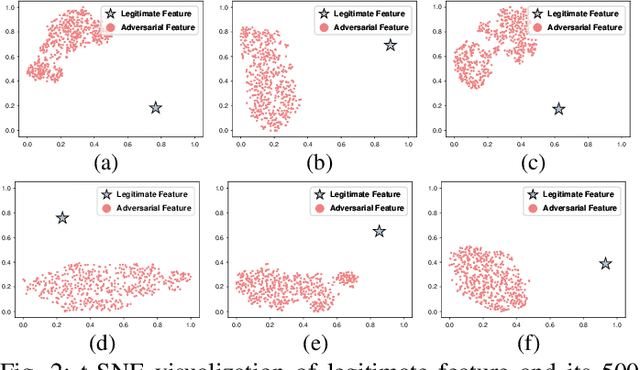

Abstract:Despite remarkable achievements in deep learning across various domains, its inherent vulnerability to adversarial examples still remains a critical concern for practical deployment. Adversarial training has emerged as one of the most effective defensive techniques for improving model robustness against such malicious inputs. However, existing adversarial training schemes often lead to limited generalization ability against underlying adversaries with diversity due to their overreliance on a point-by-point augmentation strategy by mapping each clean example to its adversarial counterpart during training. In addition, adversarial examples can induce significant disruptions in the statistical information w.r.t. the target model, thereby introducing substantial uncertainty and challenges to modeling the distribution of adversarial examples. To circumvent these issues, in this paper, we propose a novel uncertainty-aware distributional adversarial training method, which enforces adversary modeling by leveraging both the statistical information of adversarial examples and its corresponding uncertainty estimation, with the goal of augmenting the diversity of adversaries. Considering the potentially negative impact induced by aligning adversaries to misclassified clean examples, we also refine the alignment reference based on the statistical proximity to clean examples during adversarial training, thereby reframing adversarial training within a distribution-to-distribution matching framework interacted between the clean and adversarial domains. Furthermore, we design an introspective gradient alignment approach via matching input gradients between these domains without introducing external models. Extensive experiments across four benchmark datasets and various network architectures demonstrate that our approach achieves state-of-the-art adversarial robustness and maintains natural performance.
Capturing complex hand movements and object interactions using machine learning-powered stretchable smart textile gloves
Oct 03, 2024Abstract:Accurate real-time tracking of dexterous hand movements and interactions has numerous applications in human-computer interaction, metaverse, robotics, and tele-health. Capturing realistic hand movements is challenging because of the large number of articulations and degrees of freedom. Here, we report accurate and dynamic tracking of articulated hand and finger movements using stretchable, washable smart gloves with embedded helical sensor yarns and inertial measurement units. The sensor yarns have a high dynamic range, responding to low 0.005 % to high 155 % strains, and show stability during extensive use and washing cycles. We use multi-stage machine learning to report average joint angle estimation root mean square errors of 1.21 and 1.45 degrees for intra- and inter-subjects cross-validation, respectively, matching accuracy of costly motion capture cameras without occlusion or field of view limitations. We report a data augmentation technique that enhances robustness to noise and variations of sensors. We demonstrate accurate tracking of dexterous hand movements during object interactions, opening new avenues of applications including accurate typing on a mock paper keyboard, recognition of complex dynamic and static gestures adapted from American Sign Language and object identification.
Automatic Medical Report Generation: Methods and Applications
Aug 26, 2024
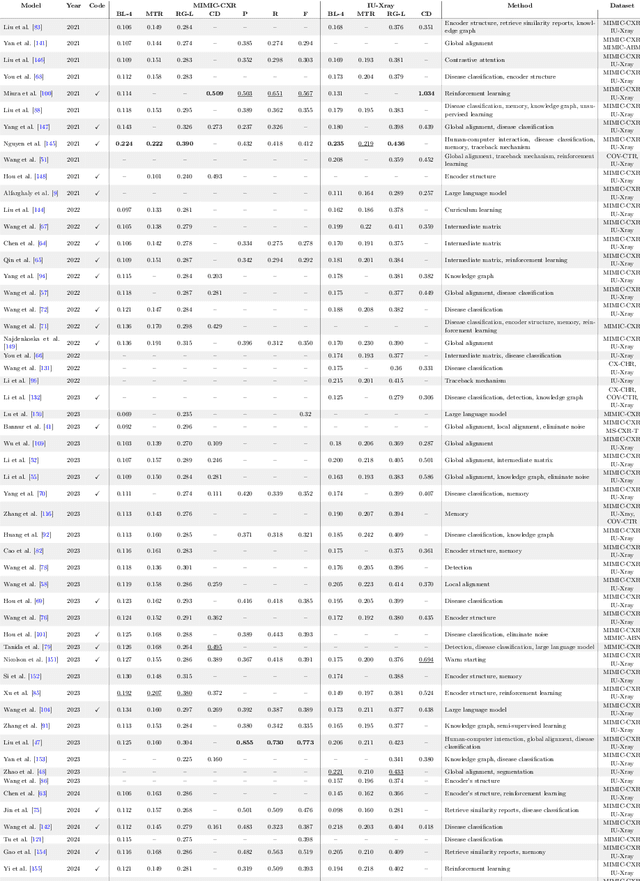
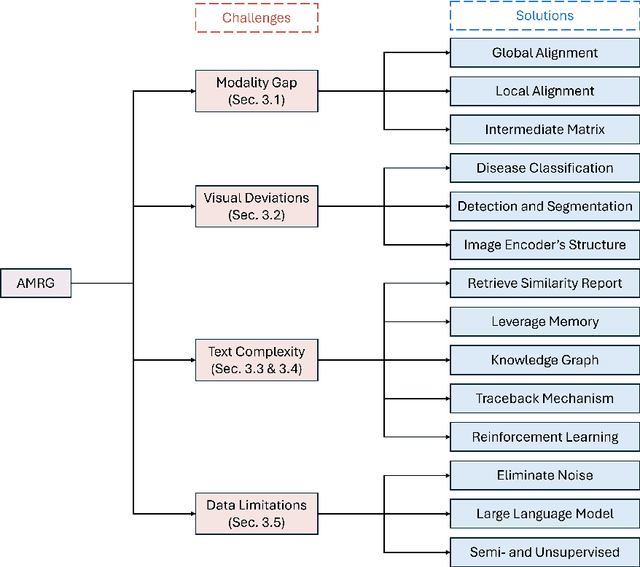

Abstract:The increasing demand for medical imaging has surpassed the capacity of available radiologists, leading to diagnostic delays and potential misdiagnoses. Artificial intelligence (AI) techniques, particularly in automatic medical report generation (AMRG), offer a promising solution to this dilemma. This review comprehensively examines AMRG methods from 2021 to 2024. It (i) presents solutions to primary challenges in this field, (ii) explores AMRG applications across various imaging modalities, (iii) introduces publicly available datasets, (iv) outlines evaluation metrics, (v) identifies techniques that significantly enhance model performance, and (vi) discusses unresolved issues and potential future research directions. This paper aims to provide a comprehensive understanding of the existing literature and inspire valuable future research.
AI-Enhanced 7-Point Checklist for Melanoma Detection Using Clinical Knowledge Graphs and Data-Driven Quantification
Jul 23, 2024



Abstract:The 7-point checklist (7PCL) is widely used in dermoscopy to identify malignant melanoma lesions needing urgent medical attention. It assigns point values to seven attributes: major attributes are worth two points each, and minor ones are worth one point each. A total score of three or higher prompts further evaluation, often including a biopsy. However, a significant limitation of current methods is the uniform weighting of attributes, which leads to imprecision and neglects their interconnections. Previous deep learning studies have treated the prediction of each attribute with the same importance as predicting melanoma, which fails to recognize the clinical significance of the attributes for melanoma. To address these limitations, we introduce a novel diagnostic method that integrates two innovative elements: a Clinical Knowledge-Based Topological Graph (CKTG) and a Gradient Diagnostic Strategy with Data-Driven Weighting Standards (GD-DDW). The CKTG integrates 7PCL attributes with diagnostic information, revealing both internal and external associations. By employing adaptive receptive domains and weighted edges, we establish connections among melanoma's relevant features. Concurrently, GD-DDW emulates dermatologists' diagnostic processes, who first observe the visual characteristics associated with melanoma and then make predictions. Our model uses two imaging modalities for the same lesion, ensuring comprehensive feature acquisition. Our method shows outstanding performance in predicting malignant melanoma and its features, achieving an average AUC value of 85%. This was validated on the EDRA dataset, the largest publicly available dataset for the 7-point checklist algorithm. Specifically, the integrated weighting system can provide clinicians with valuable data-driven benchmarks for their evaluations.
ESCAPE: Energy-based Selective Adaptive Correction for Out-of-distribution 3D Human Pose Estimation
Jul 19, 2024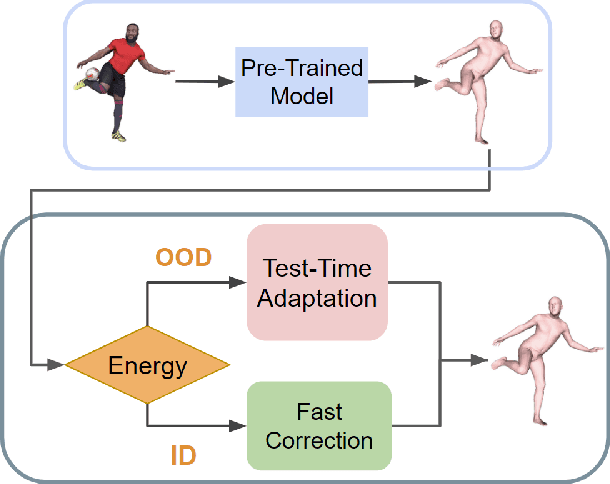
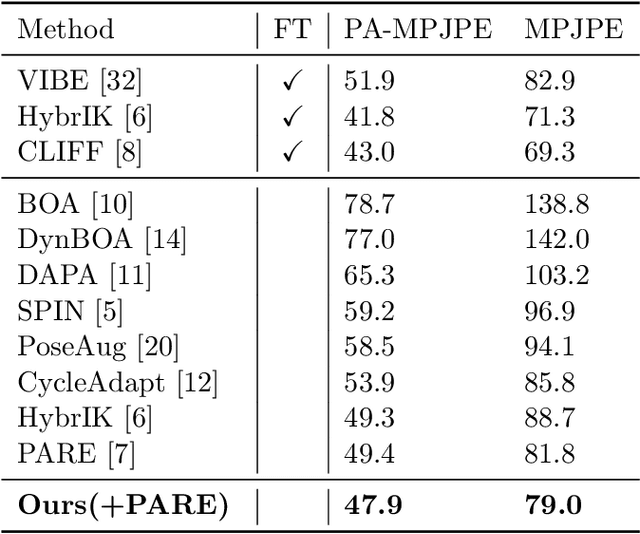
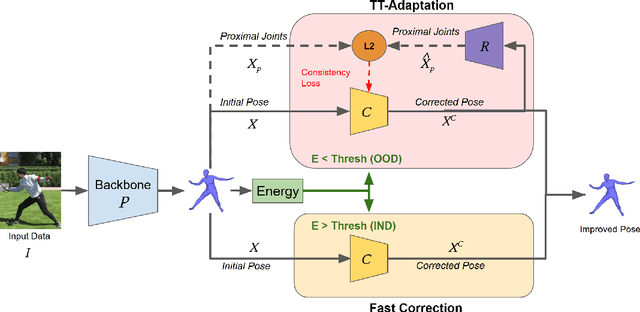
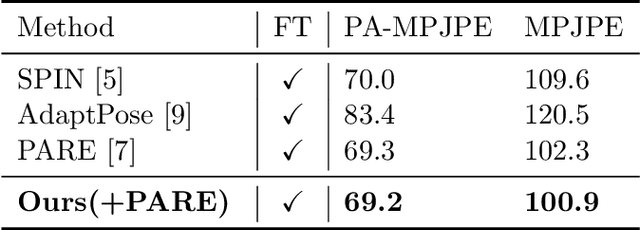
Abstract:Despite recent advances in human pose estimation (HPE), poor generalization to out-of-distribution (OOD) data remains a difficult problem. While previous works have proposed Test-Time Adaptation (TTA) to bridge the train-test domain gap by refining network parameters at inference, the absence of ground-truth annotations makes it highly challenging and existing methods typically increase inference times by one or more orders of magnitude. We observe that 1) not every test time sample is OOD, and 2) HPE errors are significantly larger on distal keypoints (wrist, ankle). To this end, we propose ESCAPE: a lightweight correction and selective adaptation framework which applies a fast, forward-pass correction on most data while reserving costly TTA for OOD data. The free energy function is introduced to separate OOD samples from incoming data and a correction network is trained to estimate the errors of pretrained backbone HPE predictions on the distal keypoints. For OOD samples, we propose a novel self-consistency adaptation loss to update the correction network by leveraging the constraining relationship between distal keypoints and proximal keypoints (shoulders, hips), via a second ``reverse" network. ESCAPE improves the distal MPJPE of five popular HPE models by up to 7% on unseen data, achieves state-of-the-art results on two popular HPE benchmarks, and is significantly faster than existing adaptation methods.
CCDM: Continuous Conditional Diffusion Models for Image Generation
May 06, 2024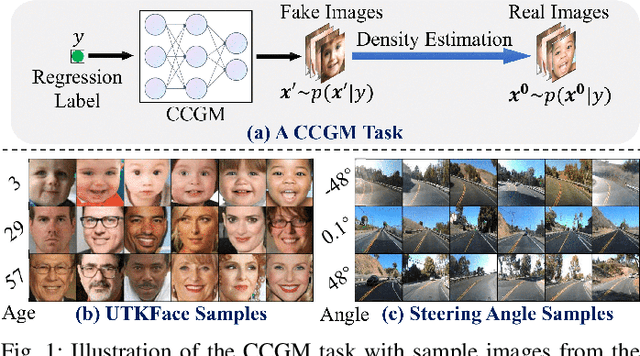
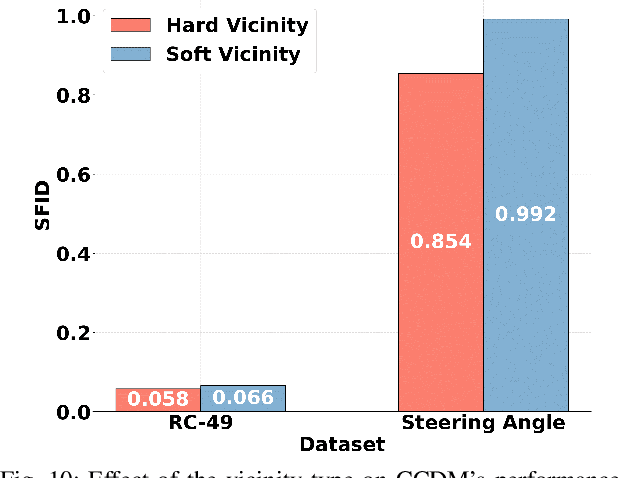
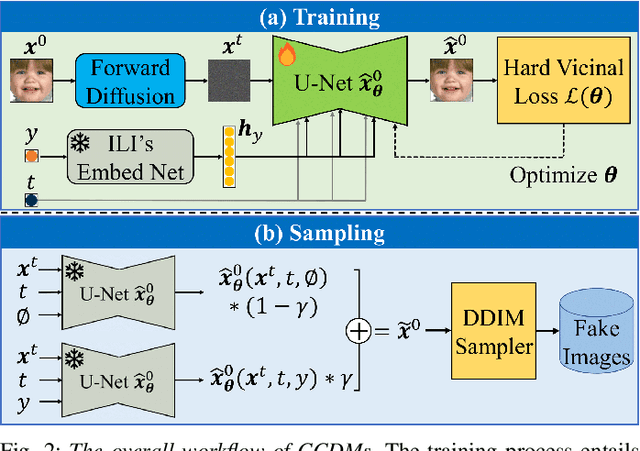
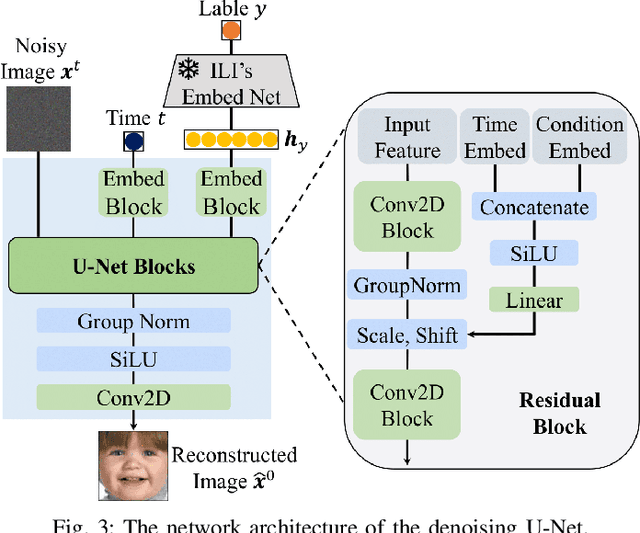
Abstract:Continuous Conditional Generative Modeling (CCGM) aims to estimate the distribution of high-dimensional data, typically images, conditioned on scalar continuous variables known as regression labels. While Continuous conditional Generative Adversarial Networks (CcGANs) were initially designed for this task, their adversarial training mechanism remains vulnerable to extremely sparse or imbalanced data, resulting in suboptimal outcomes. To enhance the quality of generated images, a promising alternative is to replace CcGANs with Conditional Diffusion Models (CDMs), renowned for their stable training process and ability to produce more realistic images. However, existing CDMs encounter challenges when applied to CCGM tasks due to several limitations such as inadequate U-Net architectures and deficient model fitting mechanisms for handling regression labels. In this paper, we introduce Continuous Conditional Diffusion Models (CCDMs), the first CDM designed specifically for the CCGM task. CCDMs address the limitations of existing CDMs by introducing specially designed conditional diffusion processes, a modified denoising U-Net with a custom-made conditioning mechanism, a novel hard vicinal loss for model fitting, and an efficient conditional sampling procedure. With comprehensive experiments on four datasets with varying resolutions ranging from 64x64 to 192x192, we demonstrate the superiority of the proposed CCDM over state-of-the-art CCGM models, establishing new benchmarks in CCGM. Extensive ablation studies validate the model design and implementation configuration of the proposed CCDM. Our code is publicly available at https://github.com/UBCDingXin/CCDM.
 Add to Chrome
Add to Chrome Add to Firefox
Add to Firefox Add to Edge
Add to Edge